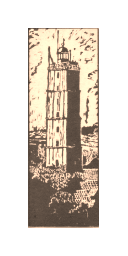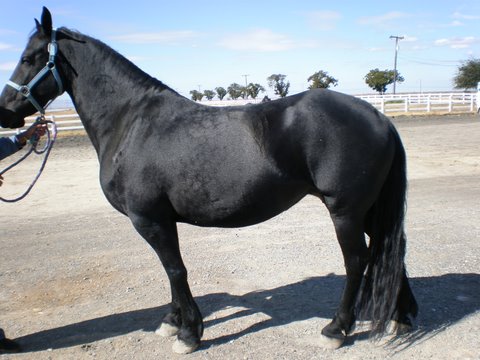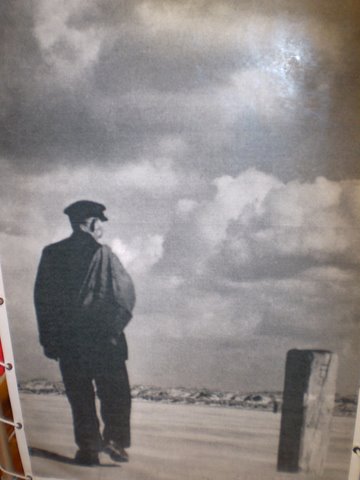
Hinne de Jong
A Chronicle
translated/arranged by his son, Sense de Jong
Mobilization (1914-1918)
- 1: Introduction
- 2: Captain Pieter
- 3: Childhood years
- 4: Shipwreck
- 5: Teenager
- 6: Spring remembered
- 7: That's how it was
- 8: Pre World War I
- 9: Mobilization (1914-1918)
- 10: Boys will be boys
- 11: Hinne leaves Terschelling
- 12: Hinne meets his true love
- 13: An eventful move
- 14: A serious illness
- 15: The war years (1940-1945)
- A1: Memories of Pa (by Truus)
- A2: Memories of Moe (by Truus)
- A3: Pa talks again
- A4: Cornelis Jacob de Jong
Another site by Sense de Jong:
~ Sense de Jong ~
Reminiscences
Sites by Henry de Jong:
~ Herman de Jong ~
Memorial
~ Newmaker Notes~
Writings, Pictures, Collections
~ AACS/ICS Niagara Conferences~
1970 - 1991
The de Jong family needed another horse and they knew there was one for sale in the little village of Hee. They also knew that this was a fiery and frisky animal. Opa Cornelis and Herman didn’t dare come near her, but they were interested. The price was rather high, about 980 guilders. First, let’s go home and talk about it, they said. The owner promised she wouldn’t sell it to anyone for a while.
The horse they were talking about became one of the most beloved animals that ever found a home on the de Jong farm. They name her the “Zwarte” (Blackie). When Opa Cornelis heard that a certain Jan Tjebbes Wulp wanted to buy the horse, Opa immediately paid the required amount.
That’s how this fiery mare came to the village of West- Terschelling. With fear and trembling they parked the Zwarte in her stall. Few dared to walk behind her because she had a deadly kick. To put the Zwarte in front of the wagon wasn’t easy at first, but her companion was the tame Amelander. In time they became used to each other and became a wonderful team.

What the 'Zwarte' might have looked like.
The Zwarte had to do most of the share of hard work and grew calmer in time. Still, when she foaled, she snorted like a true horse and roared like a lion when anyone came too close. During this time, the Zwarte was often tied to a long rope. Trouble was, someone had to move her eventually and she would then come at you with nostrils flaring. Herman, Hinne’s brother, carried a horsewhip and when the Zwarte saw that thing she’d back off. However, Herman wasn’t always around. When the horse and her foal were grazing on the dike and people wanted to walk by them, the mare scared the wits out of them. They would come to Opa Cornelis and complain.
The Zwarte had to be shod in a separate stall at the blacksmith’s. Hinne remembered that he once visited the smith in Midsland. As usual, the Zwarte’s hind legs were tied to a steel rod and Hinne held her in front. But one of the blacksmith’s men decided to tickle the horse. The Zwarte snorted and jumped up with her forelegs and came down heavy on Hinne’s wooden shoes. Those guys thought it was funny, but they ended up paying for a new pair of wooden shoes!
Quicksand!
During the years of mobilization (1914-1918) the Dutch Government - which remained neutral during WW I - positioned a ship of the Dutch Navy in the “Amelander Gat,” also called the “Borndiep.” This “gat” (opening) was the Wadden Zee-North Sea connection between the east side of Terschelling and the island of Ameland.
In normal weather, supplies to this ship arrived by sea. Hinne wrote about a period when the sea level was exceptionally low, so that no ship via the Wadden Zee could approach this location.
The de Jong family received orders to bring a load of groceries etc. using the wagon and horse power. And so, one day, Hinne put the Zwarte Sr and the Zwarte Jr. in front of the wagon, leaving West-Terschelling at 10 a.m. He had installed the surfboards on each side in order to take more supplies along.
His companion on this memorable trip was a fellow-Terschellinger, a Navy man, whom Hinne only knew as “Gert van Japke,” i.e. Japke’s son (or husband) Gert. First they took the 14- kilometer, paved- road from West to Oosterend. There they turned left on the sandy road that would take them to “Paal 18" on the North Sea beach. The water was very low and Hinne encouraged the horses to trot on the hard, sandy surface. Soon, they arrived at what is now called the famous nature reservation” De Boschplaat” (a European Union-protected wildlife area).
(Note:: Corrie and I spent the better part of a day during the 1999 summer on “De Boschplaat.” It was a day we will not easily forget. It’s impossible to describe the majesty and immensity of this vast reservation and its endless beaches. We were there during a heat wave. Strange mists wafted in from the calm sea and then disappeared again. We never heard such “stillness” before either. - sdj)
Hinne wrote: “What a sensation it was for us to ride between Terschelling and Ameland in an area where few people ever had set foot.”
How far on “De Boschplaat” did Hinne go? From “Paal 18" to “Paal 30" is 12 kilometer, far away from civilization. Arriving there they saw the Navy vessel in the sea. A sloop approached them and they soon transferred their load into it.
Quickly turning around, they took the same route back to “Paal 18.” But, suddenly, the horses bolted! Hinne knew immediately what was wrong. The Zwarte Sr. knew she was no longer on firm ground. Quicksand! The Zwarte Sr. literally flew away, dragging Junior with her. The horses, terror-stricken, fought and clawed through it and, finally, reached hard sand. Hinne remembered how dead-tired both horses were. They just stood there, shaking all over.
Gert said: “Nou, wae sol noe tinke dat hir doekelsan weze sol!” (translation: “Now, who would have thought that we’d find quicksand here!”) Hinne wrote that from above you couldn’t see the dreaded quicksand if you tried. They were back in West-Terschelling at 10 o’clock in the evening and were happy to be home.
In later years, whenever Hinne vacationed on Terschelling and met “Gert van Japke,” Gert would say: “Wat habbe wi da een moaie reis han Hinne, nei it Amelander Gat” (translation: “Hinne what a beautiful trip we made to the Amelander Gat”).
Another “Boschplaat” adventure
One day, Hinne found himself with the Zwarte and the wagon near “Paal 22,” way beyond Oosterend. This was an area where many eggs could be found. Hinne unhooked the Zwarte from the wagon and told her to stay. Hinne went searching for eggs. Meanwhile, he was fighting off all the seagulls that were strafing him from above. Perhaps the seagulls scared the Zwarte, too, because, suddenly, she bolted and flew off in a westerly direction.
Hinne ran after her leaving the eggs and the wagon. In the distance, he saw that the horse had found her way into the dunes at “Paal 18.” After running many kilometers, Hinne found the Zwarte at a farm in Oosterend. A farmer had seen the horse and grabbed her reins.
Hinne mounted the horse and rode back to where it all happened. He had learned another important lesson: always make sure your horse is tied up!
Protected by God
Hinne gave a detailed account of a scary incident that happened around this time during one of the many trips they made to the North Sea beach.
Hinne was asked to pick up a load of planks and, this time, he used the long wagon with the two horses. Along came his brother Piet and someone named Kees Funke. The long wagon consisted of a front section on two wheels and a two-wheeled back part connected with a long beam. Hinne’s passengers sat on the rear part.
The Dutch Navy had installed planks across water-filled sections of the beach. These rather narrow bridges were used by people to get to the sea faster. While using one of these bridges one of the rear wheels suddenly went over the edge. Hinne looked back, saw the back part turn over, throwing both Piet and Kees through the air.
What happened next was even more serious. The beam, between the front and back part, snapped off right behind Hinne. This caused the front section to flip forward throwing Hinne on the ground between the horses and what was left of the wagon. Fortunately, he managed to start running like crazy. To make things worse, the horses spooked and began to bolt.
Hinne wrote: “ Fortunately, I was able to hold onto the reins. Something needed to happen fast. I was in great danger of being dragged under the wagon and get killed. Another fortunate thing was that neither the Zwarte Sr. or Junior kicked back in panic. So, I decided to grab the long tail of the nearest horse, pulled myself forward using all my strength, and in a mighty jump swung myself clear to the side, rolling over in the soft sand. Still holding the reins, I was dragged along until, finally, the horses stood still. My legs were still intact and soon I was on my feet. God’s protective hand had, indeed, reached out and spared my life!”
The three of them somehow managed to re-connect the two parts in a makeshift fashion. They even continued the trip they had planned and brought home a oad of timber to the farm.
Disposal of Mines
The Zwarte was a horse with tremendous strength. A Naval mine drifted ashore near “Paal 8,” close to the hotel/restaurant. To disarm this mine or dynamite it was too dangerous because of the close proximity to this establishment. That mine had to be pulled away to a safer place.
The disposal experts asked Hinne to help out using horse power. Obviously, they couldn’t get too close to the mine. The experts noticed that the dangerous contact prongs were clearly visible, so that was a good sign. But the mine was not allowed to topple over when pulled. After studying the situation, they attached a 100-meter rope to the mine and Hinne asked the Zwarte to slowly start pulling. The Zwarte pulled and pulled, but the mine didn’t move an inch.
Then they did something risky: the rope was shortened to 50 meters! This was a dangerous - and foolish - procedure, but it worked. Carefully, the mine started sliding away from the hotel. Eventually, it was safely exploded.
During the years 1914-1916 quite a few mines drifted ashore. One day, Hinne and the disposal people started at “Paal 18,” close to Oosterend, and began working towards the West. A stick of dynamite was placed beside each mine. The men lit a fuse and then jumped on Hinne’s wagon and away they went, as fast as possible. About 300 meters away they heard the explosion. That went on throughout the whole day. There were so many mines that the men sometimes ran out of fuses.
No problem, they said. Make the fuses shorter and get away faster. Hinne wrote that no one got hurt, but he remembered that pieces of shrapnel sometimes hit the ground in front of the moving wagon. These were tense days and the work was hard on the Zwarte.
Beachcombing in a storm
Around this time, whenever something could be found on the beach, five farmers from West Terschelling would collectively go out beach combing, rather than compete with each other. Hinne recalled one New Year’s Eve adventure when together they trekked from “Paal 2" to “Paal 7.” The weather was ugly. It stormed, it rained , and it hailed. Visibility was bad and they found nothing.

This was strange because the wind was favorable for beach combing. Also, they noticed that the level of the sea was constantly rising. This could happen during spring-tide conditions. Suddenly, they found themselves surrounded by water. They were on an island of sand.
In normal circumstances, they would be going back over the “Noordvaarder” aiming for the lighthouse Brandaris. But if they went straight for the Brandaris, they would have to go through water far too deep. They decided to find a route back to “Paal 3,” sticking close to the dunes. For two hours they struggled along. The horses were mostly under water, but they stayed on their legs. The passengers got soaking wet, sitting in water most of the time. Finally, they found a way into the dunes, but there was no path. The men started walking in front of the horses, trying to keep the wagon from overturning. Finally, they arrived at the path that is adjacent to “Doodemanskisten” (translation: dead men’s coffins) - a cemetery area where already then many islanders and victims of the sea were buried. They returned home safely.
The Zwarte gets sick
The Zwarte foaled nearly every year. Her offspring became priced colts or fillies. But, one day, there was great concern after she foaled because her afterbirth remained stuck in her. The Zwarte also suffered from rheumatism in her hind legs. It became so bad that she was sometime unable to get up.
One Sunday afternoon, Piet - Hinne’s brother - and his girlfriend (would that have been Tante Alie?) sat on the top of a dune. From this height, they saw the Zwarte down on the ground. Piet immediately went there and tried to scare the mare up. The stench of the afterbirth was just awful and the horse was too smelly to be touched. Brother Herman arrived and quickly cut himself a willow branch. With Piet pulling by the tail, Herman let the horse have it, and finally, the Zwarte stood.
Piet’s Sunday suit was a mess. For a long time he stood beside a ditch to wash his hands and get rid of the stench and clean his suit. His girlfriend was far from happy. But the Zwarte was happy. Obviously, she hadn’t eaten for a long time and started to graze.
A farmer from Hoorn, a certain Willem Cupido - who often acted as a veterinary - came over the next day and helped the Zwarte get rid of the afterbirth. Afterwards, the Zwarte faithfully continued to do her work for some time yet.
Hinne wrote: “Later, when I was in the military service, I received a letter from home stating that the Zwarte had broken a leg and had to be put down. That news hit me as though a member of my family had died.”
[an error occurred while processing this directive]